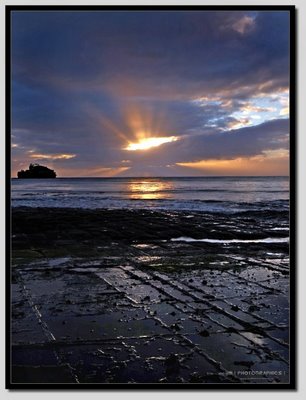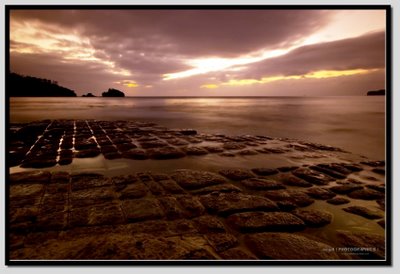The Tessellated Pavement is an inter-tidal rock platform - a common enough coastal landform. But here an unusual set of geological circumstances have resulted in a rare landform.
The flat-lying siltstone was cracked by stresses in the Earth’s crust, possibly The energy of the waves have significant impact on the coastline (in Scotland waves have been known to exert over 32 tonnes of pressure per square m) and similar stresses may have resulted in features such as the Blowhole on the Peninsula. Hydraulic action is aided by compressed air pushed into cracks and fractures in the rocks. The retreating water results in the expansion of air which can often be an explosive force, heard as a deep thud from above. Abrasion Particles driven by waves also erode coastlines. Sand and pebbles can be thrown against the rocks surfaces with great force.
Similarly the surf acts as a softer yet more repetitive force, dragging fragments back and forth between 160 million years ago and 60 million years ago. The resulting cracks (joints) are seen as three main sets, one aligned to the north- northeast, a second to the east-northeast and the third to the north-northwest. This jointing, exaggerated by processes of erosion, has created the ‘tiled’ appearance. When seawater covers the rock platform, fragments of rock are carried away. Near the seaward edge of the platform, sand is the main cause of the erosion. When combined with wave action the erosional process causes ‘loaf’ or ‘pan’ formations.
Source


 Me at the Tessellated Pavement - I had to get up at 3am to be there for sunrise. Picture taken by Rick Kean (thanks Rick!!)
Me at the Tessellated Pavement - I had to get up at 3am to be there for sunrise. Picture taken by Rick Kean (thanks Rick!!)
The flat-lying siltstone was cracked by stresses in the Earth’s crust, possibly The energy of the waves have significant impact on the coastline (in Scotland waves have been known to exert over 32 tonnes of pressure per square m) and similar stresses may have resulted in features such as the Blowhole on the Peninsula. Hydraulic action is aided by compressed air pushed into cracks and fractures in the rocks. The retreating water results in the expansion of air which can often be an explosive force, heard as a deep thud from above. Abrasion Particles driven by waves also erode coastlines. Sand and pebbles can be thrown against the rocks surfaces with great force.
Similarly the surf acts as a softer yet more repetitive force, dragging fragments back and forth between 160 million years ago and 60 million years ago. The resulting cracks (joints) are seen as three main sets, one aligned to the north- northeast, a second to the east-northeast and the third to the north-northwest. This jointing, exaggerated by processes of erosion, has created the ‘tiled’ appearance. When seawater covers the rock platform, fragments of rock are carried away. Near the seaward edge of the platform, sand is the main cause of the erosion. When combined with wave action the erosional process causes ‘loaf’ or ‘pan’ formations.
Source


 Me at the Tessellated Pavement - I had to get up at 3am to be there for sunrise. Picture taken by Rick Kean (thanks Rick!!)
Me at the Tessellated Pavement - I had to get up at 3am to be there for sunrise. Picture taken by Rick Kean (thanks Rick!!)